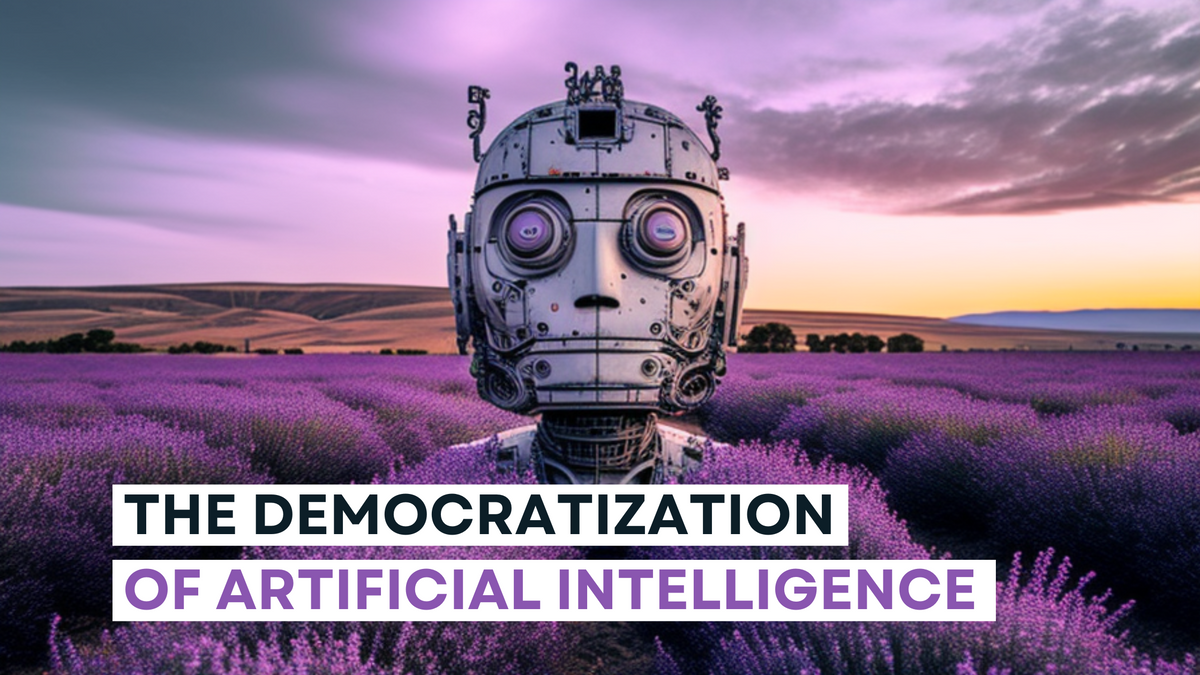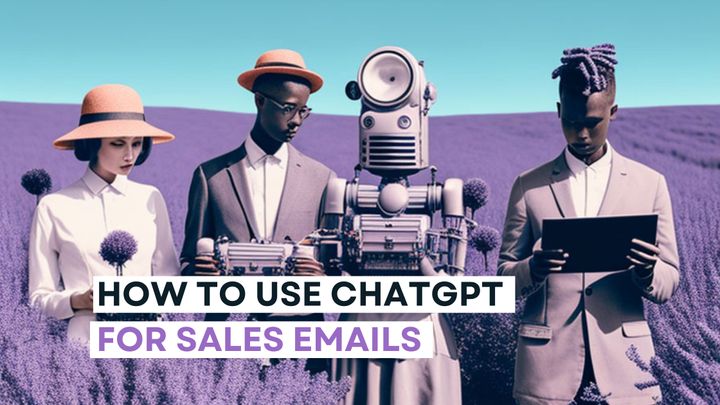The Democratization of AI and How it's Unleashing a World of Possibilities
AI democratization is not a marketing stunt or fad. It’s a movement that revolutionized our day-to-day lives. Here’s all you need to know.

Every day, we’re closer to a thrilling reality: an AI-assisted life tailored to our unique needs.
We've evolved from inventions like a basic alarm clock to an AI alarm app that wakes you up creatively and prepares you for the day, Painstakingly composing personalized cold emails to AI sales tools that help you do that easier and faster, and using human interior designers to an AI interior designer that keeps getting better.
All these innovations, impressive as they are, are only possible today because of the democratization of AI.
AI Democratization, AI for everybody
A little bit of history first. Only a few institutions and people could develop AI technologies in the 1950s, i.e. early days of AI. These early founders were the only ones who knew machine learning (ML) and had access to significant computing power.
Then, in the late 1980s, Richard Stallman developed the GNU’s Not Unix (GNU) project to create a free and open-source system. Open-source is when a source code is publicly available for anyone’s use.
Richard aimed to create an alternative to the proprietary and closed-source operating systems (private source code) used at that time.
His project laid the ground for AI democratization, making AI accessible to everyone, irrespective of background or technical abilities. AI-specific open-source projects were released a decade later, allowing developers to build on existing AI technologies.
From there on, the AI movement gained momentum, going from exclusivity to equality. Recently, the release of ChatGPT, an AI-powered chatbot, propelled the technology further because it made AI more mainstream.
Why is the movement gaining more supporters?
Google also had conversational AI technology (similar to what ChatGPT uses) a few years ago but didn’t release it. Meta released their version, BlenderBot 3, but only in the US and it had terrible reviews.
In 2020, the US government filed an antitrust lawsuit against Google. The company was accused of monopolizing search and subverting the competition. They do this by paying billions of dollars annually to be the default search engine on mobile devices.
These events, coupled with the release and chatter around ChatGPT sparked mass outrage. As people reasoned, if not for OpenAI (they developed ChatGPT), it would take years for the general public to access such powerful technology.
Kenneth Dintzer, the Justice Department lead lawyer in the Google antitrust case, said, “What has been going on for the past 12 years is Google has been maintaining its monopoly.
Would we have seen ChatGPT six years earlier? Would we see five other competitors competing for search? Those are questions none of us can answer.”
The danger in allowing a tech giant to monopolize AI research and control the technology is why more people are getting on board the AI democratization train.
It prevents this monopoly and puts the power in the hands of the people. The more competition companies have, the more innovation we get and the more we progress as a society.
Democratization for the people: what they stand to gain
The pros of democratization outweigh any advantages centralization might have. I’ve detailed some below.
Innovation across every sector
The most significant benefit of Generative AI (the subset of AI that produces content, i.e., text, image, audio, video, etc.) going mainstream is how it will birth innovations that’ll penetrate every inch of the market.
Years ago, creating an AI product required a Ph.D. in machine learning (ML), a lot of money, or both. However, democratization lowered the barrier of entry so even new developers can innovate and find unique solutions to people's problems.
Case in point: I don’t have a Ph.D. and don’t know how to build an ML model. Yet, with democratization, I adopted Large Language Models (AI models that specifically generate text) to co-found Lavender to help salespeople.
According to McKinsey, 2023 is Generative AI’s breakout year owing to more democratization efforts by companies like OpenAI and the success of ChatGPT and DALL-E 2. Here are some of these products across different industries.
Essentially, democratization opens the door to more innovation in every industry, which will impact everyone’s lives (hopefully positively).
More sophisticated products for users
As we saw in the case of Google and Meta, monopoly and lack of competition are bad for society. The dominating companies lack the incentive to innovate as much and improve people’s lives.
But with democratization comes competition as there are more entries into the marketplace. This means users have more options. They are not limited to a crappy tool because they now have alternatives.
It’s a good thing as it keeps the first-movers on their toes and ensures they innovate on their products, give good UX experience, and optimize for quality. They know customers can move to the competition anytime if unsatisfied.
Ultimately, users get the most sophisticated products because companies try to outdo the competition.
Affordable access to AI tools
Incredibly, we can access AI solutions without paying through our noses. AI tools today are either free to use or low-priced, a reality impossible without democratization.
Why? Building underlying models costs a small fortune as you must hire an AI engineering team, train AI models, and run these models before developing on top of them.
If everyone who wanted to create an AI tool had to go through this, the costs of tools would be astronomical. Not to mention that smaller companies and independent developers will be left out because they can’t afford the innovation costs.
For example, we planned to hire many AI engineers to build Lavender. This initiative would require millions of dollars. But because of democratization, we hired backend engineers to leverage these LLMs instead. It’s a win-win.
We didn’t spend as much money building as we could have, thus, we didn’t need to pass off those huge costs to our customers, making our product affordable.
With all these amazing benefits, you would be hard-pressed to find any fault with democratization. But it does have its challenges.
Achilles’ heels and how to resolve them
The decentralization of AI could be a double-edged sword because it could lead to problems like…
The spread of misinformation
LLMs are powerful, no doubt. But they can also lie and distort facts partly because of the limit of their training and because they are trained to churn out texts. So they’ll make up answers if necessary to keep going.
AI being easily accessible means it’s available to people who might believe and publish its lies, spreading misinformation from harmless to severe.
One way to reduce the potential of misinformation going viral is educating people on the limitations of AI. When using these tools, they should always know to fact-check the results and include a human in the loop.
These tools should issue disclaimers and advise people not to copy their results verbatim. ChatGPT does something like this on the footer of their website:
Increased fraudulent activities
Another ripple effect of AI being mainstream is it’s a magnet for illegal activities. For instance, AI can help create more sophisticated hacking and phishing systems and evade fraud detection systems.
It can also develop convincing deepfakes (although you might need Photoshop for polishing) to manipulate, blackmail, and impersonate people.
However, promoting cybersecurity awareness for people, implementing regulations, and creating even more sophisticated fraud detection systems can curb these resultant crimes.
Democratization Initiatives
Open-source AI projects and platforms
Open-source code projects like TensorFlow, PyTorch, Keras, Hugging Face Transformers, and Fast help democratize developers with free libraries for learning and communities to collaborate.
Platforms like Google Colab and Kaggle allow developers to write, execute, share code, and collaborate with others, all of which help more and more people create cool products.
Open APIs
The API of products like ChatGPT, Bing AI, and DALL-E 2 are available, meaning developers only need to pay (a relatively affordable amount) to integrate them into their applications.
All-in-one solutions
Then, there are solutions like Metal and Baseplate that make it easy and fast for developers to build AI products.
AI education and training
Beyond making it easy for developers to build products, we must also consider the general public. More education and training on AI are needed to make democratization genuinely complete.
That’s why there are articles and affordable courses on best prompts and best AI practices to show people how to use AI tools to get optimal results.
The future is AI-Assisted
The ideal end case of AI democratization is how these tools will alter and assist us in every aspect of our lives.
If the technology were centralized, the company in charge would choose where to apply it and where not. They could even plunge us into a version of the matrix — a dystopian future.
But decentralization spreads the power, and innovators get to innovate across every niche. I won’t be surprised if there is a tool that can remind me of my dreams when I wake up tomorrow.
Author bio: Casey is the CTO and co-founder of Lavender, where he is responsible for product and engineering. Lavender is an AI-powered sales email coaching platform with over 20,000 active users, including customers like Twilio, Sendoso, Clari, and Sharebite.
An early adopter of large language models (like OpenAI’s ChatGPT), Casey takes a practical approach to applying AI to solving costly communication problems.
Before joining his cofounders, Casey was the CTO of an early-stage fashion PR automation startup after graduating from New York University in three years.



